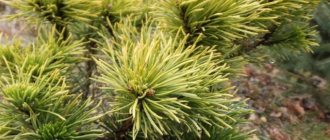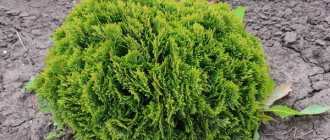The globular willow is one of the few garden plants that can be very functional with a rather non-trivial appearance. This tree can be used both as a bright decorative element and for strengthening water banks, etc. An elegant and at the same time quite unpretentious tree to care for is what experienced gardeners can say about the globular willow. Further on the features of growing willow, the best varieties, planting features, etc. (detailed photos are attached for your reference).
Willow globular: description, main varieties and varieties
The globular willow is a unique tree that can grow into a small dwarf or become a real giant, reaching 15-20 m in height.
It all depends on the characteristics of a particular variety. The external feature of any of the varieties of spherical willow is its luxurious rounded crown, which, thanks to the densely growing leaves, turns into a beautiful green lush hat. In this case, the lower part of the branches and the trunk remain completely bare. Ball willow is an excellent honey plant, which is often planted near apiaries. In addition, willow can withstand the cold very well. Even at -40ºС it is able to survive. The plant is widespread not only on Russian territory, but also throughout the Eurasian continent and even in Africa and Australia. If we talk about the territory of Russia, then the following varieties of spherical willow are optimally suited for our open spaces (below photo):
- Purple. This low shrub got its name due to the unusual color of its flexible thin shoots and earrings - bright purple. The crown diameter reaches only 2 m.
purple willow
- Whole leaf Hakuro Nishiki. Depending on the characteristics of cultivation, the variety can look like a shrub or a full-fledged small tree with branches hanging down slightly. The tips of the leaves of a young plant are distinguished by a bright pinkish-white color.
- Eared. A rather impressive-sized shrub, distinguished by brownish stems (young) and grayish branches.
long-eared willow
- Globular dwarf (hybrid). A very beautiful variety, represented by a small tree (about 2-3 m in height and width), characterized by a very dense and lush leaf crown.
- Sverdlovsk sinuous (hybrid). The tree is of medium height, reaching 4-5 m. The crown is not very dense, the branches are drooping. The leaves are a little curly.
Sverdlovsk twisting willow
- Lighthouse (hybrid). It was bred for weaving vines. Currently represented by a beautiful lush spherical bush, reaching about 3 m in height.
How to plant and grow willow
Hello everyone! I haven't been here for a long time, but now I'm back with you! And today we will talk about willow - perhaps the most widespread woody plant in Russia.
Willow (Salix)
Well, think for yourself: in general, about 600 species of willows are found in nature. And about 100 of them grow in our country. This is only in the wild!
In different places, willows are called differently. If you come across the following names - willow, willow, willow, lozina, vine, willow - know that this is all willow. By the way, the name “lozina” or “vine” is not unfounded - the branches of almost all types of willows are very flexible and therefore are used in wicker weaving. And sometimes they are even planted specifically for this purpose.
Willow, also known as basket willow or twig willow (Salix viminalis)
Willows come in different forms: in the form of shrubs or trees, tall and low, with completely different leaves, twigs and bark color.
Willow (Salix integra) 'Hakuro Nishiki'
But more on that later, but now let’s move on to the main thing.
Planting a plant in open ground
The globular willow differs from most plants not only in its unpretentiousness, but also in its excellent survival rate in places where most plants will die. Thus, the spherical willow loves moisture and will take root well in places where groundwater accumulates. It's all about the incredible resistance of the willow root system to the effects of an excessively humid environment. Accordingly, willow roots will not rot even if there is standing water in the soil.
Since willow loves light very much, it is advisable to choose a bright place for planting in open ground. Immediately before planting, prepare holes about 0.4 m deep and about 0.5 m wide. 1/3 of the hole is filled with a nutrient mixture consisting of compost, peat, and nutrient soil. The period for planting willow is quite wide: seedlings can be planted in open ground from mid-spring to mid-autumn. The main condition for successful planting of willow is not very dry roots and a ball of earth.
Growing: 100% survival rate
Only those gardeners who have nowhere to take cuttings propagate the globular willow by seeds. In spring, the plant is covered with many fluffy light clouds, this is what its inflorescences look like. Ripe seeds are difficult to collect; with the slightest breath of wind they are spread throughout the area. In addition, after a few days the seeds are not suitable for germination.
Advice! It must be borne in mind that an adult tree can grow up to 6-7 m in height. If during planting it was planned to grow a compact specimen, then care is required with regular pruning of shoots in the spring to a length of up to 0.5 m.
To prevent cuttings from growing roots, you need to try very hard - willow easily takes root in water or wet sand. Before sap flow begins, annual shoots are cut and cuttings 30-40 cm long are cut. Each of them should have 3 to 6 healthy buds left. Further actions:
- Oblique cuts of the shoots are dried and sprinkled with crushed coal.
- Prepare containers with calcined river sand.
- The cuttings are planted at a distance of 10-20 cm from each other.
- Moisten the sand generously.
Read also: How to make beehives with your own hands: materials, how to make a drawing, what principles to use to build
At room temperature, willow seedlings will begin to grow within a month. Caring for them consists only of periodic watering. The best time for planting is in early spring, as soon as the top layer of soil has thawed. But even if the seedlings are placed on the site in summer, the tree will take root well.
Reproduction of globular willow
Reproduction of globular willow is usually carried out by vegetative methods: cuttings or rooting in water. In the first case, you need to carefully select the material for planting, which a special nursery will definitely help you with.
Globular willows in the nursery
The optimal period for willow propagation is early spring. Young shoots are cut (the lower cut must be oblique) about 30 cm long. Each shoot must have at least 5 fully formed buds.
It is advisable to choose a planting site with moist soil: a wetland or area with close groundwater is ideal. A few hours before propagation begins, it is advisable to immerse young shoots in a solution with biostimulants to “wake up” the plants. After this, you can safely plant in open ground.
If you bought planting material in the fall, you need to take care of its preservation until spring. To do this, just carefully wrap the shoots in polyethylene and place them in a room with a cool, damp environment (a basement is perfect for these purposes).
When propagating plants using the second method, cuttings are cut in the spring, immediately before planting, and placed in containers filled with water. Small cuts can be made at the bottom of each branch to encourage root formation. As soon as the first roots grow on the cuttings, they can be planted in nutritious, moist soil.
Planting: moving to the lawn
Ball willow takes root especially well in slightly acidic loamy soils. If the soil is too dense, add a couple of buckets of sand and mix thoroughly. When growing a compact ornamental tree, you can play it safe and lay a layer of expanded clay (10-20 cm) on the bottom of the hole. A hole is dug corresponding to the size of the seedling - usually about half a meter deep and the same width is enough.
Advice! Trees are not removed from peat pots, but planted directly in them. When grown in cups, planting is carried out using the transshipment method (together with a lump of earth).
Two-thirds of the excavated soil is mixed with a bucket of rotted manure and a small amount of any mineral fertilizer, then the mixture is placed back into the hole. The seedling perfectly tolerates being buried on several buds, thereby growing additional roots. Sprinkle the planting site with soil and compact it well. All that remains is to pour a few buckets of water under the willow root.
Features of wood care
Although willow is considered a fairly unpretentious and very hardy tree, it, like any other plant, needs timely and complete support from the gardener who grows it in open ground. Next, about the features of caring for willow.
Willow needs to be fed at least 2 times a year
Fertilizing and watering regime
As noted earlier, willow loves moisture very much, so the tree must be watered generously and often. Depending on the size of the tree, the volume of water should be about 20-50 liters (per tree). The watering procedure is carried out twice a month. During very hot dry periods, you can increase the frequency of watering to 4 times a month.
Advice. If you want to simplify the care of the globular willow and minimize the amount of watering, you just need to plant a young tree in an area that is flooded with groundwater. And then you can forget about moistening the soil in the area where the willow grows.
During the spring-autumn period, it is advisable to apply complex mineral fertilizer at least a couple of times, and at the end of summer - also a nutritious organic complex. If, towards the end of the summer period, gray-black dots with a coating begin to appear on the willow leaves, this is the first signal that the plant does not have enough copper: take care to immediately apply fertilizer.
In autumn, all fallen leaves should be removed and, if necessary, wild growth should be removed from the area. With the onset of cold weather, varieties that are not resistant to low temperatures must be “insulated” with breathable material.
Plant type
The plant loves moisture very much, so it is often planted on the banks of ponds and lakes. It is easy to care for, easily tolerates fairly low temperatures in our country, and reproduces easily. Forms wide dense crowns.
In autumn, the leaves acquire a beautiful yellow color, sometimes with a reddish tint. In spring, cute fluffy inflorescences called “seals” appear on thin branches. They serve as a harbinger of spring.
The elongated leaves on the inside are gray with a bluish tint, which makes the plant especially beautiful. The globular willow reaches a height of 20 meters in adulthood, reaching three meters in the crown. Planting willow is not difficult.
Disease and pest control
Unfortunately, willow is quite susceptible to various pests, so you should detect them in a timely manner and begin combating them immediately. The most dangerous and common willow pests include:
Willow is susceptible to disease, so carry out preventative treatment
- Willow weevil. The most dangerous willow pest that can destroy the entire willow garden. It lives actively and quickly destroys the plant. The result is huge, in some cases, tunnels that cover the willow, and then a sharp drop of foliage. The weevil is most active in August. Unfortunately, there is no method of pest control. The only thing that can be done is to remove the damaged parts of the tree.
- Aphid. Unfortunately, this pest is known to many gardeners firsthand. Lives in large colonies, attacking young willow shoots. As a result, the tops of the branches are destroyed and the leaves turn yellow. Control method: kerosene-soap solution. About 2.5 liters of kerosene and 0.5 kg of green soap must be diluted in 75 liters of water. Spraying of the tree is carried out in the evening in the absence of strong wind.
- Willow cicada. Likes to lay numerous eggs in willow shoots. The result is cracked bark, an abundance of side shoots, and drying out of the main shoots. The fighting method is mechanical. To begin, generously coat the willow branches with tar/glue. All that remains is to wait for the pest and collect it manually.
- Leaf beetle. Black, as if burnt leaves and partially bare branches - this is what the activity of the leaf beetle can lead to. Control method: removing parts of the tree damaged by the pest and catching the beetle with bait in boxes coated with any adhesive.
Combination of willow with other plants
Thanks to its original, sophisticated appearance, spherical willow is actively used as a decorative element in landscape design. The spherical willow is excellent for landscaping both parks and avenues, as well as private garden plots.
Globular willow in landscape design
With proper care and proper placement among other garden plants, globular willow can become a real work of art. The plant looks great in tandem with other shrubs.
It is often used in combination with bonsai when decorating Japanese-style gardens. It can be used as a single plant, since over time the branches of the tree become brittle and, falling, create a lush original halo around the tree.
Excellent decoration can be obtained by growing globular willow near ponds. Decorative stones are usually laid out in front of the tree, and the circle around the trunk is decorated with ground-blooded flowers.
Advice. Ball willow is an excellent plant for strengthening slopes. Usually, for this purpose, varieties with a crown height of at least 3 m are planted.
That's all you need to know to successfully grow globular willow in any garden. Good luck!











